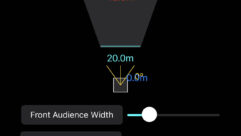Vertical Reality
May 1, 2001 12:00 PM,
Bryan White
Vertical Reality
Spectacular Video Game Made Possible by Splitter RouterMixer
By Bryan White
GameWorks, the entertainment venture formed by Steven Spielberg andDreamWorks SKG, Universal Studios and Sega Enterprises, offers guestsup to 150 games and attractions coupled with a full-service restaurantand bar. The fourteen venues, which have been visited by more than 25million guests in the past year, are designed to provide the ultimatesocial experience by combining the best games, attractions, music,video and technology in a lively, dynamic environment.
GameWorks draws visitors into the experience through high energy,visually stimulating “zones” that offer a range of games from suchclassics as Asteroids, Pac-Man and pinball to the best in racing,adventure, sports action, motion simulation, and proprietarythrill-ride attractions. At the center of the action, and serving as agateway to the other zones, the Arena welcomes guests withlarger-than-life visuals and signature attractions. It is in the Arenathat guests can find Vertical Reality, a Steven Spielberg original,which allows 4 to 12 players at a time to compete in an interactivevertical challenge game. Strapped into their seats, gamers race theclock to rid a skyscraper of its criminal elements, or navigate apirate ship through the air via a hot air balloon in a highly chargedjousting tournament. A talented player can ascend a total of 24 feet -but once vulnerable will descend in a virtual free fall.
Behind the Scenes
The Vertical Reality game is designed around an independentlycontrolled bay. At some GameWorks sites, the game has as many as threebays, allowing 12 people to play simultaneously. Other sites have oneor two bays. Each bay has a master computer that communicates with fourslave computers over an Ethernet network. Each slave computer controlsthe video and audio for one of the four levels. The master computeralso communicates with the programmable logic controller (PLC) thatcontrols the movement of the four chairs. The chairs are mounted onI-beams. A motor at the base of each I-beam drives a chain, which isattached to each chair. When a chair moves from one level to another,sensors mounted on the I-beam relay the chair’s position to the PLC.The PLC then transmits the chair’s position information to themaster computer, which tells the slave computer controlling that levelto play the next segment of the game.
Computer Automation Engineering was originally hired by SegaGameWorks to select an industrial PC and develop the interface betweenthe PC and the PLC. CAE was also asked to devise a way of connectingthe players’ joysticks to the master computer. The challenge here wasthe distance the signal had to travel. With each chair capable ofmoving 24 feet, a 60-foot cable was required to transmit the joysticks’signals to the master computer. At that distance, the 5-volt signalfrom a typical joystick is subject to inaccuracy caused by electricalnoise. CAE chose an off-the-shelf joystick called Wingman Warrior fromLogitech that has a built-in analog-to-digital converter. The converteddigital signal is then transmitted via an RS-232 to RS-485 converter tothe master computer.
After its success with these projects, CAE was also asked to add awireless microphone to the audio system for Vertical Reality. Thechallenge here was finding a mixer that could handle six inputs and atleast five outputs. CAE selected the SRM 66 programmable splitter mixerrouter from Rane Corp., Mukilteo, Washington.
This device was well suited to the requirements for Vertical Realitybecause it allows independent routing and mix-level adjustment of anyinput to any output. In this situation, CAE had to mix theinputs—microphone, master computer CD-ROM, and slave computergame sounds—and send them out to five outputs, the speakers inthe four chairs, the background speakers and the chair butt buzzers.For example, the SRM 66’s first output port mixes the background musicfrom the CD-ROM, the audio from computer #1, and instructions from agame staff member to chair one. The SRM 66 made this possible byallowing each output to have a unique programmable mix of the sixinputs. Mix configurations are stored in up to 12 EPROM memories thatrequire no batteries. The SRM 66 also allows input and leveladjustments for proper mixing levels.
Rack-Mounted System
In addition to the SRM 66s, the audio system also uses two MA6Samplifiers. The MA6Ss are 6-channel amplifiers built by Rane Corp.Amplifiers are necessary because all of the SRM-66 outputs areline-level audio. This lower-level signal minimizes distortion, but itneeds amplification before being sent to the speakers. The Rane MA6Swas chosen because it has six 100-watt outputs and is UL listed.
CAE’s final task for this game was to select and install all thecomputer and audio hardware for each bay. The master and slavecomputers are all single-board computers that fit into a passivebackplane chassis. These were bolted to an industry-standard 19-inchrack. The Rane splitter mixer router, the Rane amplifiers, and theElectro-Voice amplifier were attached to the same rack.
The audio and other systems that CAE designed for Vertical Realityhave performed perfectly, and the game has been a big hit for SegaGameWorks. The fee to play Vertical Reality is typically $3 per person.At one location, over 100,000 people played the game in its first sevenmonths of operation. That kind of response tells Sega GameWorks thatthe multilevel concept is a hit. The company is planning to installmore Vertical Reality games at other GameWorks sites, and isconsidering other games with a third dimension. Now that the basiccontrol system for Vertical Reality has been developed, it willsimplify the creation of new multilevel games.
GameWorks was created as the ultimate entertainment destinationwhere guests can eat, drink, party and play in a dynamic and energeticenvironment. Each location features a full-service bar and restaurantin addition to a multitude of interactive games and exclusiveattractions. There are 14 GameWorks locations worldwide—a dozenvenues in the United States and two international locations in Guam andRio de Janeiro, Brazil.
The managing members of Sega Game Works, L.L.C. are wholly-ownedsubsidiaries of Sega Enterprises, DreamWorks SKG and Universal Studios.Universal Studios is a unit of The Seagram Company Ltd., a globalentertainment and beverage company.
For more information contact Rane Corporation, 10802 47th Ave West,Mukilteo, WA 98275. Phone: 425-355-6000; Fax: 425-347-7757; Web site:www.rane.com. Bryan White is president of Computer AutomationEngineering, Newport Beach, California.










